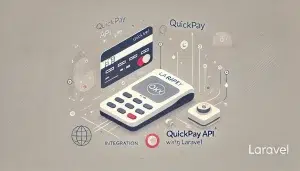Introduction
Managing payments in web applications can be challenging, especially with evolving standards and security requirements. The Quickpay API offers a robust solution for payment processing, and a dedicated Laravel package can simplify its integration into your projects. In this article, we’ll explore how to utilize this Laravel package, its benefits, and best practices for seamless implementation.
What is Quickpay API?
Quickpay API is a comprehensive payment gateway solution that supports various payment methods, including credit cards, mobile payments, and bank transfers. Its robust features ensure secure and efficient transaction processing.
Features of Quickpay API:
- Support for multiple payment methods: Credit/debit cards, mobile wallets, and more.
- High-security standards: PCI DSS compliance for secure transactions.
- Scalability: Suitable for startups to enterprise-level businesses.
Why Use a Laravel Package for Quickpay?
A Laravel package provides pre-built integrations, saving development time and reducing potential errors. Here’s why a dedicated package makes sense:
- Simplified API Calls: Pre-configured endpoints for easier communication.
- Error Handling: Built-in mechanisms to manage API errors.
- Ease of Use: Laravel’s eloquent syntax and ecosystem integration.
Installing and Configuring the Laravel Quickpay Package
Step 1: Installation
Use Composer to install the Quickpay package:
composer require vendor/laravel-quickpayStep 2: Publish Configuration
Publish the configuration file for customization:
php artisan vendor:publish --provider="Vendor\QuickpayServiceProvider"Step 3: Set Up Environment Variables
Add your Quickpay API credentials to the .env file:
QUICKPAY_API_KEY=your_api_key
QUICKPAY_SECRET=your_secretStep 4: Add Middleware
Ensure that the necessary middleware is registered for secure transactions.
Implementing Quickpay API Features
1. Processing Payments
The Laravel package provides a streamlined method to process payments. Here’s an example:
use Vendor\Quickpay;
$response = Quickpay::charge([
'amount' => 1000, // in smallest currency unit, e.g., cents
'currency' => 'USD',
'source' => 'card_token',
]);2. Handling Refunds
Initiate refunds easily:
$response = Quickpay::refund([
'transaction_id' => 'txn_12345',
'amount' => 500,
]);3. Payment Status
Check the status of a transaction:
$status = Quickpay::status('txn_12345');Example Use Cases
1. E-Commerce Applications
Seamlessly integrate Quickpay for secure customer checkouts.
2. Subscription-Based Services
Automate recurring payments for subscription models.
3. Donation Platforms
Provide donors with multiple payment options and smooth processing.
Comparison: Laravel Quickpay vs Other Payment Gateways
| Feature | Laravel Quickpay | Stripe | PayPal |
|---|---|---|---|
| Multiple Payment Methods | Yes | Yes | Yes |
| PCI Compliance | Yes | Yes | Yes |
| Ease of Integration | High | Medium | Medium |
Key Takeaways
- Efficiency: The Laravel package for Quickpay simplifies integration and reduces development effort.
- Security: Leverages Quickpay’s PCI DSS compliance for secure transactions.
- Versatility: Suitable for various applications, from e-commerce to SaaS platforms.
FAQ
Q1: What payment methods does Quickpay support?
A: Quickpay supports credit cards, mobile wallets, bank transfers, and more.
Q2: Is the Laravel Quickpay package compatible with all Laravel versions?
A: Ensure compatibility by checking the package’s documentation. Most packages support Laravel 8 and above.
Q3: How secure is Quickpay?
A: Quickpay complies with PCI DSS standards, ensuring secure payment processing.
Q4: Can I customize the Laravel Quickpay package?
A: Yes, the package is open-source and allows extensive customization.
Q5: Where can I find documentation?
A: Visit the official Quickpay API documentation.
Conclusion
Integrating Quickpay API into your Laravel application becomes effortless with the dedicated Laravel package. Its robust features and ease of use empower developers to build secure and efficient payment solutions, making it a top choice for modern web applications.


